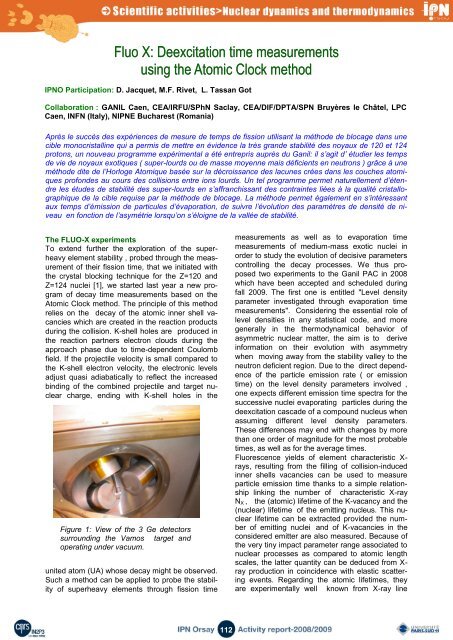exotic nuclei structure and reaction noyaux exotiques ... - IPN - IN2P3
exotic nuclei structure and reaction noyaux exotiques ... - IPN - IN2P3
exotic nuclei structure and reaction noyaux exotiques ... - IPN - IN2P3
You also want an ePaper? Increase the reach of your titles
YUMPU automatically turns print PDFs into web optimized ePapers that Google loves.
Fluo X: Deexcitation time measurements<br />
using the Atomic Clock method<br />
<strong>IPN</strong>O Participation: D. Jacquet, M.F. Rivet, L. Tassan Got<br />
Collaboration : GANIL Caen, CEA/IRFU/SPhN Saclay, CEA/DIF/DPTA/SPN Bruyères le Châtel, LPC<br />
Caen, INFN (Italy), N<strong>IPN</strong>E Bucharest (Romania)<br />
Après le succès des expériences de mesure de temps de fission utilisant la méthode de blocage dans une<br />
cible monocristalline qui a permis de mettre en évidence la très gr<strong>and</strong>e stabilité des <strong>noyaux</strong> de 120 et 124<br />
protons, un nouveau programme expérimental a été entrepris auprès du Ganil: il s’agit d’ étudier les temps<br />
de vie de <strong>noyaux</strong> <strong>exotiques</strong> ( super-lourds ou de masse moyenne mais déficients en neutrons ) grâce à une<br />
méthode dite de l’Horloge Atomique basée sur la décroissance des lacunes crées dans les couches atomiques<br />
profondes au cours des collisions entre ions lourds. Un tel programme permet naturellement d’étendre<br />
les études de stabilité des super-lourds en s’affranchissant des contraintes liées à la qualité cristallographique<br />
de la cible requise par la méthode de blocage. La méthode permet également en s’intéressant<br />
aux temps d’émission de particules d’évaporation, de suivre l’évolution des paramètres de densité de niveau<br />
en fonction de l’asymétrie lorsqu’on s’éloigne de la vallée de stabilité.<br />
The FLUO-X experiments<br />
To extend further the exploration of the superheavy<br />
element stability , probed through the measurement<br />
of their fission time, that we initiated with<br />
the crystal blocking technique for the Z=120 <strong>and</strong><br />
Z=124 <strong>nuclei</strong> [1], we started last year a new program<br />
of decay time measurements based on the<br />
Atomic Clock method. The principle of this method<br />
relies on the decay of the atomic inner shell vacancies<br />
which are created in the <strong>reaction</strong> products<br />
during the collision. K-shell holes are produced in<br />
the <strong>reaction</strong> partners electron clouds during the<br />
approach phase due to time-dependent Coulomb<br />
field. If the projectile velocity is small compared to<br />
the K-shell electron velocity, the electronic levels<br />
adjust quasi adiabatically to reflect the increased<br />
binding of the combined projectile <strong>and</strong> target nuclear<br />
charge, ending with K-shell holes in the<br />
Figure 1: View of the 3 Ge detectors<br />
surrounding the Vamos target <strong>and</strong><br />
operating under vacuum.<br />
united atom (UA) whose decay might be observed.<br />
Such a method can be applied to probe the stability<br />
of superheavy elements through fission time<br />
measurements as well as to evaporation time<br />
measurements of medium-mass <strong>exotic</strong> <strong>nuclei</strong> in<br />
order to study the evolution of decisive parameters<br />
controlling the decay processes. We thus proposed<br />
two experiments to the Ganil PAC in 2008<br />
which have been accepted <strong>and</strong> scheduled during<br />
fall 2009. The first one is entitled "Level density<br />
parameter investigated through evaporation time<br />
measurements". Considering the essential role of<br />
level densities in any statistical code, <strong>and</strong> more<br />
generally in the thermodynamical behavior of<br />
asymmetric nuclear matter, the aim is to derive<br />
information on their evolution with asymmetry<br />
when moving away from the stability valley to the<br />
neutron deficient region. Due to the direct dependence<br />
of the particle emission rate ( or emission<br />
time) on the level density parameters involved ,<br />
one expects different emission time spectra for the<br />
successive <strong>nuclei</strong> evaporating particles during the<br />
deexcitation cascade of a compound nucleus when<br />
assuming different level density parameters.<br />
These differences may end with changes by more<br />
than one order of magnitude for the most probable<br />
times, as well as for the average times.<br />
Fluorescence yields of element characteristic X-<br />
rays, resulting from the filling of collision-induced<br />
inner shells vacancies can be used to measure<br />
particle emission time thanks to a simple relationship<br />
linking the number of characteristic X-ray<br />
N X , the (atomic) lifetime of the K-vacancy <strong>and</strong> the<br />
(nuclear) lifetime of the emitting nucleus. This nuclear<br />
lifetime can be extracted provided the number<br />
of emitting <strong>nuclei</strong> <strong>and</strong> of K-vacancies in the<br />
considered emitter are also measured. Because of<br />
the very tiny impact parameter range associated to<br />
nuclear processes as compared to atomic length<br />
scales, the latter quantity can be deduced from X-<br />
ray production in coincidence with elastic scattering<br />
events. Regarding the atomic lifetimes, they<br />
are experimentally well known from X-ray line<br />
112

















